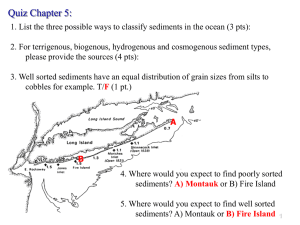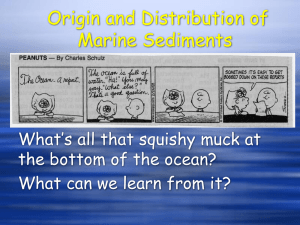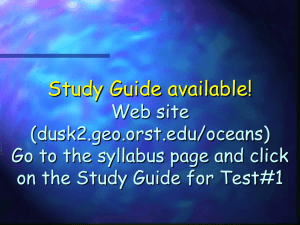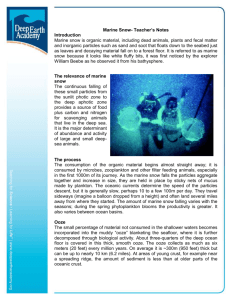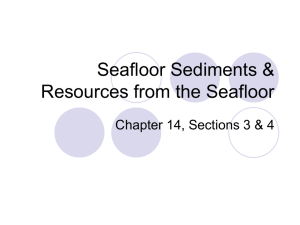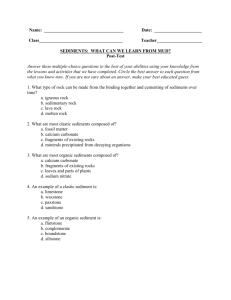Ch. 5 Marine Sediments Lecture Notes Page
advertisement
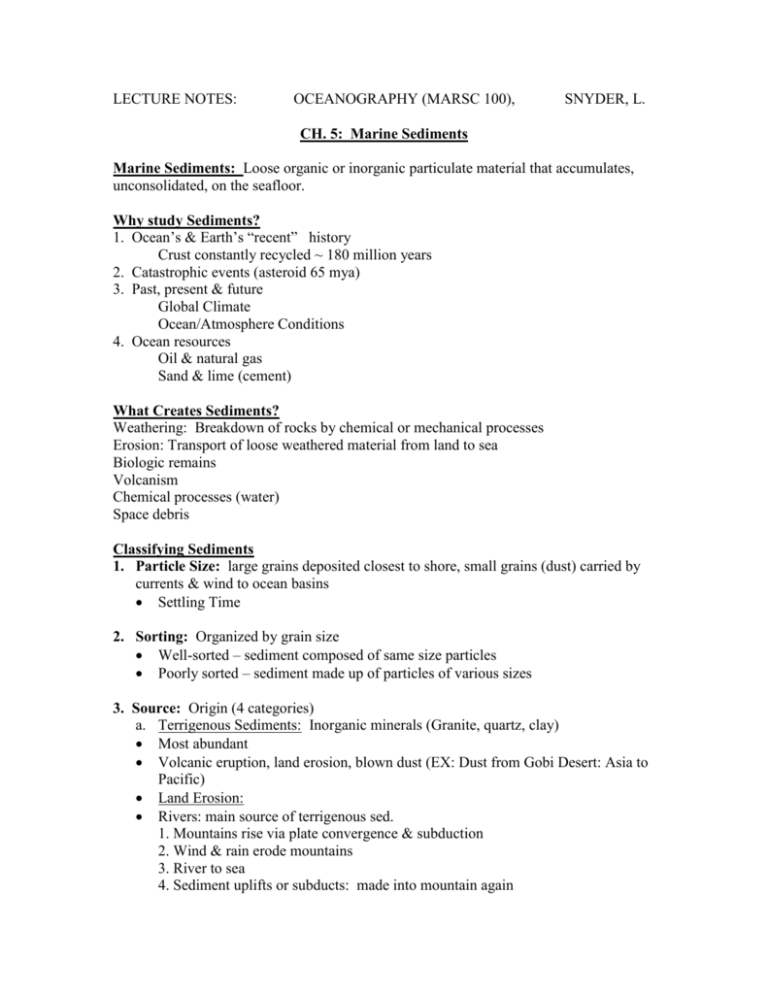
LECTURE NOTES: OCEANOGRAPHY (MARSC 100), SNYDER, L. CH. 5: Marine Sediments Marine Sediments: Loose organic or inorganic particulate material that accumulates, unconsolidated, on the seafloor. Why study Sediments? 1. Ocean’s & Earth’s “recent” history Crust constantly recycled ~ 180 million years 2. Catastrophic events (asteroid 65 mya) 3. Past, present & future Global Climate Ocean/Atmosphere Conditions 4. Ocean resources Oil & natural gas Sand & lime (cement) What Creates Sediments? Weathering: Breakdown of rocks by chemical or mechanical processes Erosion: Transport of loose weathered material from land to sea Biologic remains Volcanism Chemical processes (water) Space debris Classifying Sediments 1. Particle Size: large grains deposited closest to shore, small grains (dust) carried by currents & wind to ocean basins Settling Time 2. Sorting: Organized by grain size Well-sorted – sediment composed of same size particles Poorly sorted – sediment made up of particles of various sizes 3. Source: Origin (4 categories) a. Terrigenous Sediments: Inorganic minerals (Granite, quartz, clay) Most abundant Volcanic eruption, land erosion, blown dust (EX: Dust from Gobi Desert: Asia to Pacific) Land Erosion: Rivers: main source of terrigenous sed. 1. Mountains rise via plate convergence & subduction 2. Wind & rain erode mountains 3. River to sea 4. Sediment uplifts or subducts: made into mountain again Humans alter the sediment cycle (Ex. Dams, levees, destruction of riparian habitat & wetlands). Results in flooding, severe damage from storms (Hurricanes, Tsunami, etc.) b. Biogenous Sediments: Remains of living organisms (fossilize) Hard structures (Shells, exoskeleton) Oozes (30% biogenous) o Siliceous (Silicon): EX. Diatoms (phytoplankton) o Calcareous (Calcium-carbonate): Ex. Foraminifera (zooplankton), Coccolithophore (Phytoplankton) Calcareous Ooze: Deposits of Calcium-containing shells, phytoplankton Not found below 4,500 m (14,800 ft.) Calcium carbonate compensation depth (CCCD): Calcium carbonate dissolves in seawater below 4,500 m: as pressure increases & temperature decreases. Cold, deep water is acidic & High in CO2 Siliceous Ooze: Deposits of Silica-containing organisms Common at greater depth & colder seas Diatom ooze – Antarctica (cold, nutrient-rich, upwelling) Radiolarian ooze - Equatorial (Radiolarian = amoeba-like protozoans) c. Hydrogenous Sediments: Dissolved minerals precipitated from seawater (fall out of solution) Mineral sources: rock, sediment, hydrothermal vents, land erosion o Evaporites - form in isolated seas with high evaporation [Ex. Gypsum (CaSO4), Salt (NaCl)] o Authigenic – formed in place Manganese Nodules: form via slow chemical reactions (bacteria may aid) Grow 1-10 mm (0.04-0.4”) / million years! Compositon: Manganese & iron (50%), cobalt, nickel, copper, often have shark tooth, algae, nuclei Form at depths: Pacific seafloor 30-50 % cover of Manganese nodules d. Cosmongeous Sediments: Interplanetary dust: debris (comets, collisions) falls into Earth’s atmosphere (constant) Most dissolves in seawater Minor sediment in ocean Impacts by large asteroids & comets: Crust thrown into space, melts, falls back to Earth – forms microtektites (Glass-like, 0.2-0.8mm) Classifying Sediments (cont): 4. Distribution: 3 Categories a. Neritic sediments: Continental shelf Terrigenous, Current or wave deposited , Coarse grain, Rapid accumulation b. Hemi-pelagic sediments: outer shelf & slopes c. Pelagic sediments: deep sea Mixed, but greater proportion is Biogenous, Deposited suspension, Fine grained (finest on floor), Slow accumulation Terrigenous sediment: Not carried far out to sea Result: Pelagic sediment dominated by biogenous material

